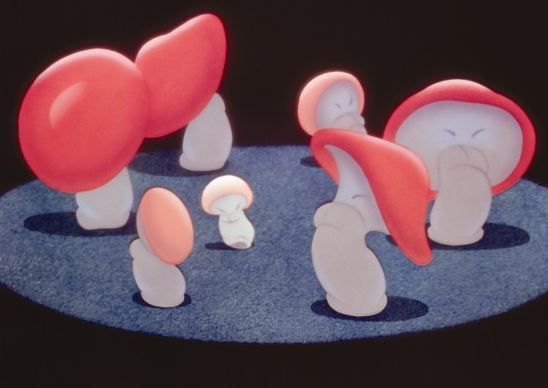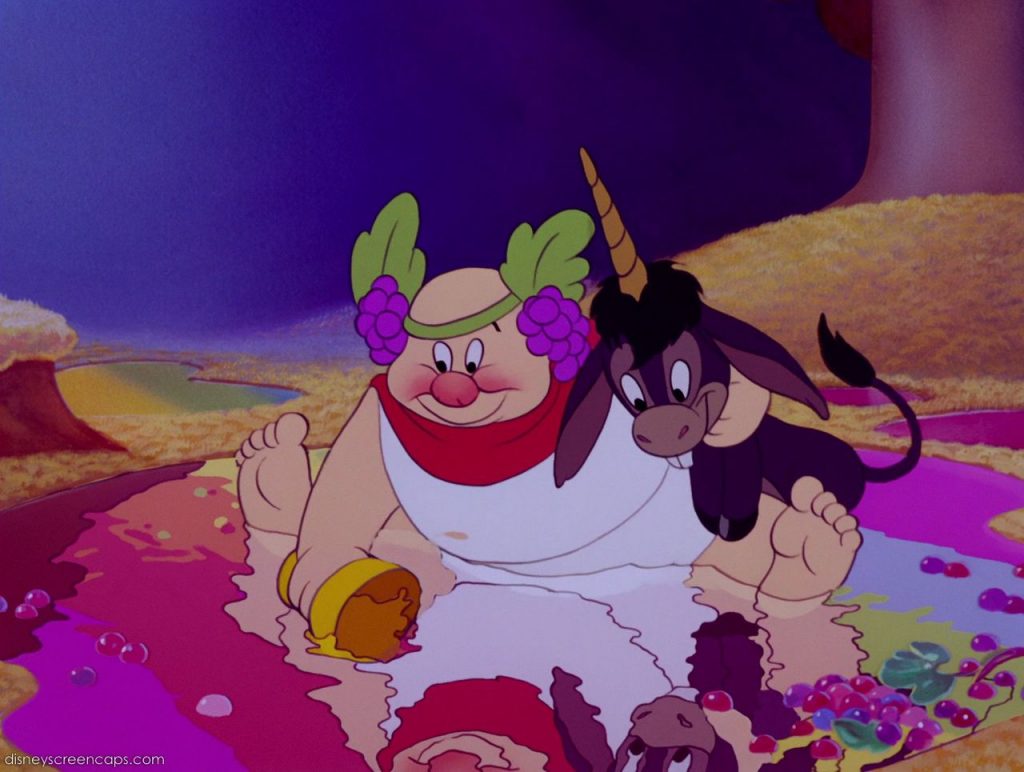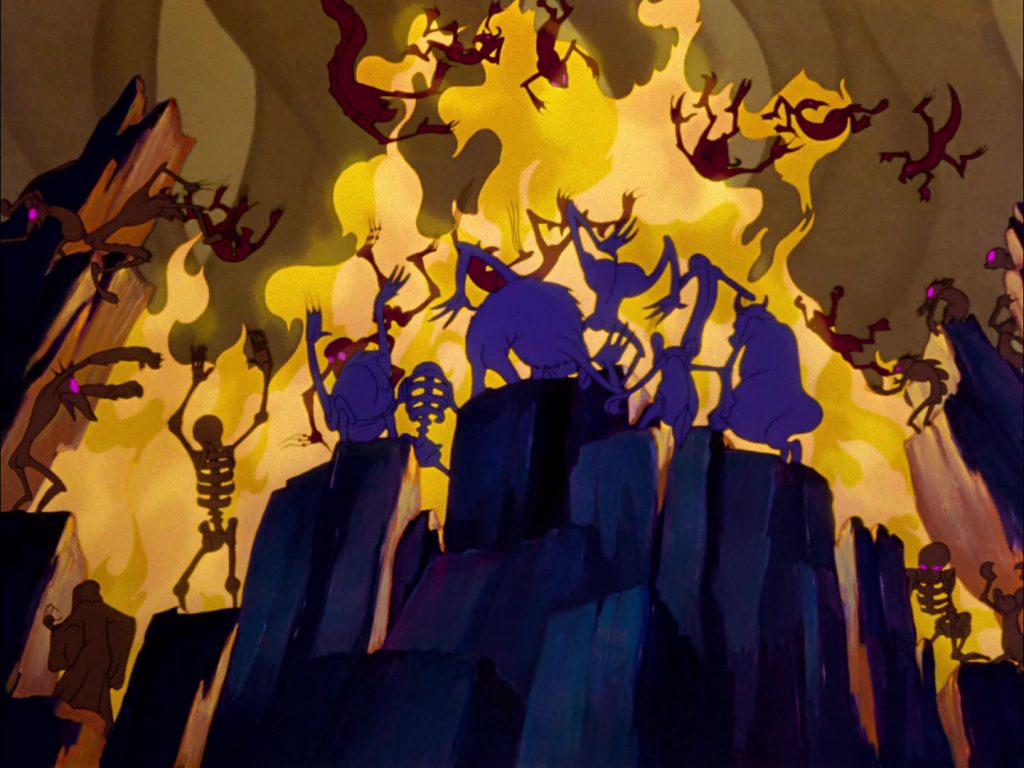Overthinking Disney: Fantasia
Fantasia is one of those movies that is older than you think it is; it was the third animated feature length film to be released by Disney, in 1940. I’ve also realised, through re-watching it for this series, that it is longer than I think it is; my sister and I used to fast-forward to the bits we liked and ignore the rest of the movie!
As such, I have no memory of the opening sequence, Toccata and Fugue in D Minor, wherein we are introduced to the orchestra and the concept of the film (animation set to/telling a musical story) through a variety of silhouettes and abstract animation. This is an interesting piece of cinema, if you remember that all of the visuals were hand drawn, with no aid from a computer, but otherwise it’s rather dull.

I do remember the next segment, in which Disney has animated fairies, mushrooms, flowers, thistles, and fish dance along to The Nutcracker ballet suite. I used to go see The Nutcracker with my mother and grandmother every year when we lived in Calgary, so I enjoy Disney’s interpretation of the familiar music. This bit of the films holds up when watched as an adult, except for the – ahem – ever so slightly racist mushrooms. (In Disney’s defence, the mushroom music was taken from the bit in the ballet where all the sweets from around the world dance for Clara and the Nutcracker, and is actually called “Tea (Chinese Dance)”, so it’s not entirely their fault.)
Next we have The Sorcerer’s Apprentice, the most famous segment in this movie. This one is an actual story set to music, and is, to my mind, what this movie does best (but Fantasia 2000 did better). We all know the tale: Sorcerer goes to bed leaving magic hat unattended; Apprentice (Mickey) uses magic hat without permission to make a broom do his petty chores; broom continues to bring water long after the well is full; flooding ensues; Mickey tries to fix things and makes it worse; Sorcerer wakes up, pissed, and has to fix things.
Interestingly, The Sorcerer’s Apprentice is the entire reason that Fantasia exists. Disney was developing a Silly Symphony to revive Mickey’s waning popularity, but it was so ambitious that it began to cost more than a short could ever recoup. Somehow, the answer was to turn the pricey eight minute segment into a very expensive 126 minute film…
After The Sorcerer’s Apprentice we have The Rite of Spring, which I just remember as ‘the bit with the dinosaurs’ – turns out it’s actually three times as long and is the bit with the space, lava, geology, micro-organisms, pre-historic fish…and then dinosaurs. See above, under fast-forward. Plot wise, it’s 2000’s Dinosaur, without lemurs. No spoiler caveat needed; we all know how things ended.
After a brief intermission, we get to ‘meet the orchestra’, via an animated sound track portrayed by a straight white line, which changes into different shapes and colours based on the sounds played.

Then we have The Pastoral Symphony, which is a re-imagining of Greco-Roman mythology via the compositions of Beethoven. This segment features an adorable baby pegasus (the creature, not the Hercules character) learning to fly, centaur and centauress couples courting (and pairing up according to colour, obviously), and naked-bottomed cupids. At the end, a festival to honour Bacchus, the god of wine, is interrupted by Zeus, who creates a storm and frightens all the aforementioned characters. A chubby Bacchus (/Dionysus ) riding on a drunk donkey-corn* is probably one of my favourite features of the entire movie; these tipsy soulmates are relationship goals.
After The Pastoral Symphony comes The Dance of the Hours, a ballet performed by animals. In typical Disney ‘flip the trope on its head’ style, the prima ballerina is a hippo. She dances a pas de deux with an alligator and… yeah, I know, I hear it. This is a weird movie okay – there are also elephants in tutus and ostriches wearing pointe shoes. But it made my friend giggle, and at least it ends here.
Or does it? As kids, we did stop the film after the ballet. That’s because the final scene is nothing short of terrifying. This is literally a segment about good vs evil, Satan vs the church; the narrator even introduces it thusly.

Wikipedia describes this segment in all it’s dark glory rather well: “Using the powers of darkness, [Chernabog -a large devil] raises ghosts, monsters, fire women, a fleet of monstrous imps, blue satyrs, witches and demons from a nearby town with a cemetery. Ghosts of criminals pass through the noose a second time, while others rise from a lake. He then also summons fire and makes the ghosts and the other creatures in his control dance and fly around, before he throws them into a volcanic pit and resurrects them as demons. Harpies fly around as the cavorting gets more chaotic, throwing unfortunate, deformed creatures into the multi-hued flames.” And yes, Disney was pitching this a children’s film.
Then we segway into the happy and eerily religious ending. With dawn’s light, a church bell tolls and, you guessed it, Satan and his goons have to retreat. We then have the song Ave Maria and a very religious candle-lit procession through a dewy forest to a church. It’s a nice ending, but oddly secular.
Overall, Fantasia is not a terrible film. There are parts of it which are eminently watchable, and, as I said before, it’s an incredibly bold and visually stunning concept. But, it runs a little long for even an ardent fan’s attention span, and there are slower/weirder moments which make me want to, well, fast forward.
Part of my Overthinking Disney series. Do let me know what you think.
Fantasia is available on DVD, Blu Ray, and Amazon Prime Video, as well as Disney+.
This site contains product affiliate links. I may receive a small commission if you make a purchase after clicking on one of these links.

